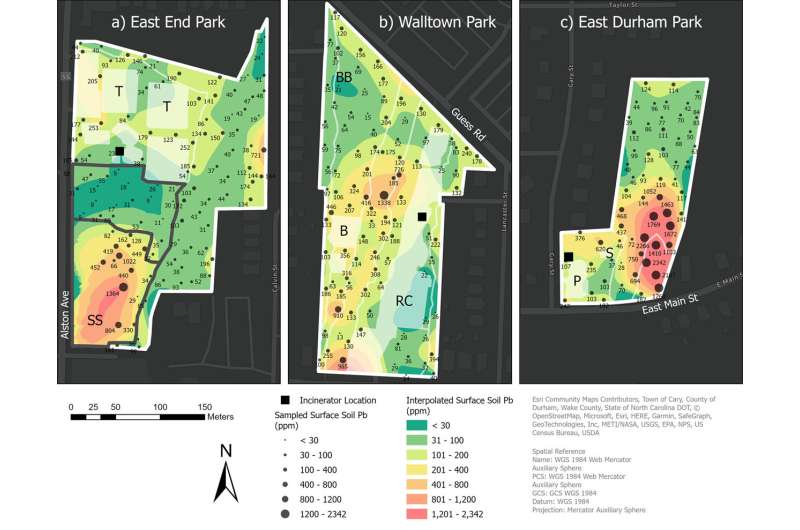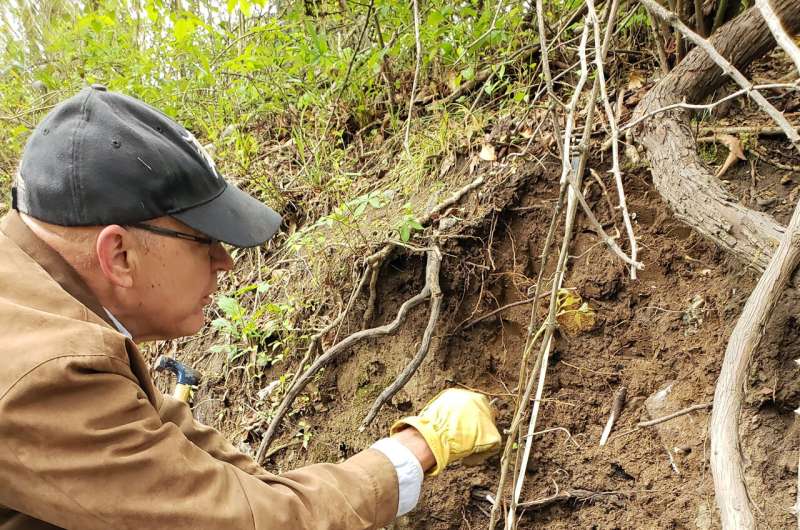This article has been reviewed according to Science X's editorial process and policies. Editors have highlighted the following attributes while ensuring the content's credibility:
fact-checked
peer-reviewed publication
trusted source
proofread
Urban parks built on former waste incineration sites could be lead hotspots, study finds

For much of the last century, many cities across the United States and Canada burned their trash and waste in municipal incinerators. Most of these facilities were closed by the early 1970s due to concerns about the pollution they added to the air, but a new Duke University study finds that their legacy of contamination could live on in urban soils.
"We found that city parks and playgrounds built on the site of a former waste incinerator can still have greatly elevated levels of lead in their surface soils many decades after the incinerator was closed," said Daniel D. Richter, professor of soils at Duke's Nicholas School of the Environment, who co-led the research.
Exposure to lead in soil has been linked to potential long-term health problems, particularly in children. These include possible damage to the brain and nervous system, slowed growth and development, and learning and behavioral problems.
To conduct their study, Richter and his students collected and analyzed surface soil samples from three city parks in Durham, N.C. that are located on former incinerator sites closed in the early 1940s.
Samples collected from a two-acre section of East Durham Park contained lead levels over 2000 parts per million, more than five times higher than the current U.S. Environmental Protection Agency (EPA) standard for safe soils in children's play areas.
Samples collected from Walltown Park mostly contained low lead levels, "but about 10% were concerning and a few were very high," Richter noted.

Samples collected from East End Park all contained levels of soil lead below the current EPA threshold for children's safety "and presented no cause for concern," he said.
The sharp differences in lead levels between the three parks underscores the need for increased monitoring, he stressed.
"Determining where contamination risks persist, and why contamination is decreasing at different rates in different locations, is essential for identifying hotspots and mitigating risks," Richter said. "Many cities should mobilize resources to do widespread sampling and monitoring, and create soil maps and, more specifically, soil lead maps."
"That's where we really need to go," Richter said. "Not just in Durham but in hundreds of other cities where parks, as well as churches, schools and homes, may have been built on former waste incinerator and ash disposal sites."
By analyzing historic surveys of municipal waste management, the Duke team found that about half of all cities surveyed in the U.S. and Canada incinerated solid waste between the 1930s and 1950s.
"These incinerators burned all kinds of garbage and trash, including paint, piping, food cans and other products that contained lead back then," Richter said. The leftover ash, in which lead and other contaminants were concentrated, was sometimes covered with a too-thin layer of topsoil or even spread around parks, new construction sites or other urban spaces as a soil amendment.
"Historical surveys indicate a lack of appreciation for the health and environmental hazards of city-waste incinerator ash. Back then, they didn't know what we do now," he said.
New technology could help make sampling and monitoring more feasible at the thousands of sites nationwide that may be contaminated, he added. Using a portable X-ray fluorescence instrument, his lab is now able to do a preliminary analysis on a soil sample for multiple metals, including lead, in just 20 seconds.
Making use of historical records about waste incineration and ash disposal could also speed efforts to identify hotspots. In their paper, Richter and his students provide histories gleaned from archived public works records, old street maps and newspaper clippings showing where ash was burned and disposed of in six sample cities: Los Angeles; New York City; Baltimore; Spokane, Wash.; Jacksonville, Fla.; and Charleston, S.C.
"This is something you could do for many cities to guide monitoring efforts," Richter said.
"There's been a lot of interest in mitigating lead exposure in cities, but most until now has been focused on reducing risks within the home. Our study reminds us that risks exist in the outdoor environment, too," he said.
Richter and his students published their findings Sept. 11 in Environmental Science & Technology Letters.
His co-authors on the new paper were Enikoe Bihari, a 2023 Master of Environmental Management graduate of the Nicholas School who conducted much of the research as part of her Master's Project, and Garrett Grewal, a senior at Duke majoring in Earth and Climate Sciences.
More information: Enikoe Bihari et al, Legacies of Pre-1960s Municipal Waste Incineration in the Pb of City Soils, Environmental Science & Technology Letters (2023). DOI: 10.1021/acs.estlett.3c00488
Journal information: Environmental Science & Technology Letters
Provided by Duke University




















